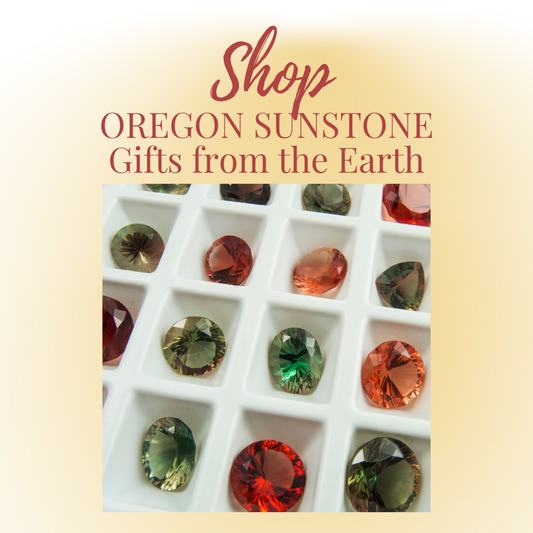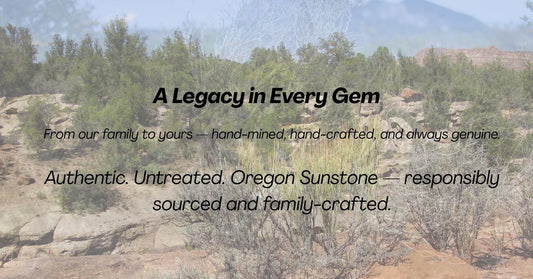Rockhounds are a special breed. Most people are attracted to bright shiny things and lots of people like to go out and enjoy nature, many are enamored of the idea of treasure hunting. But rockhounds tend to take these interests to another level, sometimes bordering on obsession. And now is the time of year when that obsession migrates from internet forums and out into the field in search of new discoveries.

Steve Douglas, holding Oregon Sunstone Crystals found at Faceter's Folly Mine.
I have been a rockhound since our families first trip to Davis Creek in Northern California to dig for obsidian in the early 70’s. It was that trip that started a lifelong obsession with rocks and gems and put me on a path to a career in jewelry making that eventually led to the creation of The Sunstone Store alongside my wife and partner of 40 years, Elyse Douglas. I started in California but the majority of my rockhounding has taken place in Oregon, the place I now call home.
Oregon is a rockhounds mecca with everything from coastal beach agates to opal in the Owyhee, plus jaspers and agates nearly everywhere in between. Yet at the pinnacle of Oregon rockhounding sits the Oregon Sunstone, a unique variety of copper bearing feldspar, the only known occurrence of copper bearing feldspar in the world.
Oregon Is A Rockhounder’s Mecca
The result of that mixing of copper and feldspar is an unparalleled range of colors for a single source gem. From near colorless through yellows, oranges, reds, plus a range of green hues sometimes standing alone and often mixed with one another. Not to mention the shiller effect that results from particulate copper forming in tiny platelets that reflect light like a multitude of tiny mirrors. It’s a rockhounds fever dream!
Surprisingly, we didn’t discover Oregon Sunstone until 2001 when a representative of Dust Devil mine walked into the store Elyse was working in at the time looking for someone interested in selling Oregon Sunstone in Bend, Oregon. Elyse was immediately smitten and not long after I started making regular trips to the mines to dig for stones myself. I haven’t been out in a while but for several years I kept a camp trailer at Dust Devil during the season to have a place to stay while I dug.
Now that the sun is out and the ground is dry in the remote Oregon Outback, serious rockhounds are laying plans for expeditions to the Oregon Sunstone mining district. If you are a novice or even an experienced rockhound that has never dug for Oregon Sunstone there are some things you should know before you go.
Remote & Starkly Beautiful-The Oregon Outback
First, it is called the Oregon Outback for a reason. It is remote, sparsely populated and services are few and far between. You will be traveling 20 plus miles off pavement on irregularly maintained roads to get there so you will need good tires and a solid spare. Plan your gas stop carefully and carry extra if you can. Coming from Bend the last chance to top up is in Christmas Valley and that’s 90 miles away. Be sure to carry food and water, lots of water, and at least an emergency blanket if not camping gear. Cell service is spotty and you may have to hike miles just to find a decent signal depending on where you are if you break down.

If you plan to visit one of the fee digging sites it is wise to make contact before you go. Online information isn’t always up to date. Weather, equipment issues, etc. can mess with intended opening schedules. Also, all the mines operate a little different from one another. Some offer screening only, some allow digging in the pit, some require reservations. And fees vary from mine to mine and the type of experience you choose. Camping is also available on site in most cases but again, service and facilities are minimal.
Plan Your Trip Carefully

The last bit of pre planning advice is to be ready for any kind of weather, even in the middle of summer. Standing in Rabbit Basin, where most of the mines are, looking at Hart Mountain in the distance it’s easy to forget that you are at nearly 5,000 feet elevation. The days can be hot and the nights can be cold, or hot! I’ve seen summertime overnight temperatures in the 80’s and the 40’s. And you can go the whole trip without seeing a cloud in the sky or you can get drenched by thunderstorms dropping hail and/or rain. In short, it’s best to be prepared to protect yourself from the sun, rain or cold.
So now, fully prepared you have made the trek to the Oregon Sunstone Mining District. You have picked a place to work and you are ready to look for Oregon Sunstone. This can be as simple as walking around and looking for crystals that have percolated to the surface. (Hot Tip: This is best done in the morning or afternoon, or after a rain, when the low angle of the sun makes the gems easier to see.) Fun, but not likely to turn up much color. For that you, or someone, is going to have to do some digging. And considering that the basin is basically covered in basalt under a layer of silt you’re not going to get far without heavy equipment. And that is why you will have more success finding color by going to one of the fee digging sites. (Listed below) There, they will set you up in a pit where you can dig in the wall, or you can dig in tailings. Or, they will put an excavator bucket full of pre-processed ore on a screening table, either flat wood or steel, or a screen. Eventually you will develop and eye for picking Oregon Sunstone out from the basalt ore but here are some tips for speeding up that process.
It’s best if your ore is dry, the silt of the basin is sticky when wet and makes it hard to discern shape or color without washing it again and water is too precious in the basin for that. Shape and color will be your big clues. But color can be deceiving because you will see some red iron oxide in the basalt that will fool you with false hope on a regular basis. So, shape can be your biggest friend because there are no flat surfaces on basalt unless it is a spot where a crystal has parted from the host rock. I have had the most success screening ore once I trained my eye to look for flat surfaces. Even though Oregon Sunstone crystals shapes are pretty irregular, somewhere on that irregular shape is a flat, or nearly flat surface unlike anything you will see in basalt.
Tips For Sucess!
Lastly, be sure to wear gloves and bring multiple pairs because digging through basalt will wear them out. Use a stick or the like to push the ore around as much as you can to extend the life of your gloves but you will inevitably need to handle a lot of basalt.
So now, properly prepared and ready for adventure, get ready to discover one of the greatest treasures Oregon has to offer, Oregon Sunstone. Good luck!

Written by Steven J. Douglas
This is a list of the mining operations that offer fee digging that I am aware of currently. These links are for their web pages but some also maintain pages on Facebook and you can sometimes find more up to date information there.
http://www.doubleeaglemine.com/
http://www.highdesertgemsandminerals.com/html/spectrum_sunstone_mines.html
https://sunsummitsunstones.com/





